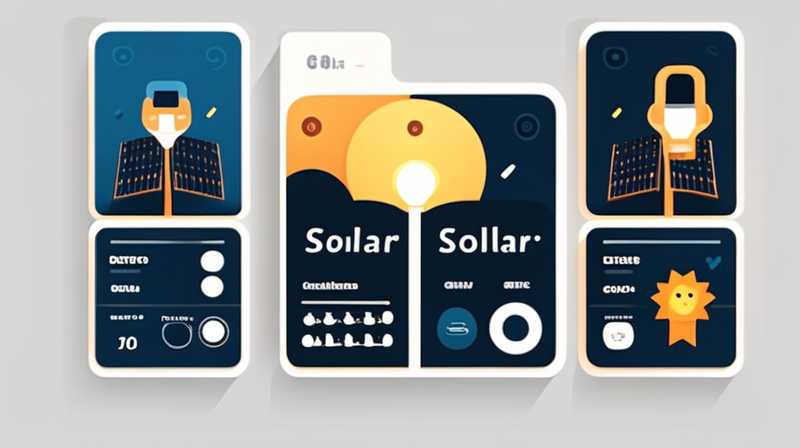
To effectively bring solar lights to an aisle, consider implementing these essential strategies: 1. Identify ideal locations for installation, 2. Select appropriate solar lighting designs, 3. Ensure ample sunlight exposure for charging, 4. Integrate solar lights with existing decor. Among these, location identification plays a critical role in maximizing the efficiency and aesthetic appeal of solar lights. Assessing foot traffic patterns and areas that require illumination will optimize visibility and enhance safety during nighttime.
1. IDENTIFYING IDEAL LOCATIONS FOR INSTALLATION
Strategically placing solar lights is essential for illuminating an aisle effectively. A systematic evaluation of the area allows for the determination of high-traffic zones and darker sections that require enhanced visibility. Pay attention to segments that are frequently used but lack sufficient lighting. By doing so, one can significantly improve the overall safety and accessibility of the walkway.
When identifying locations, prioritize areas where people are likely to walk. Installations should not obstruct movement; thus, it’s prudent to maintain a clear path. In addition, factors such as landscaping elements, existing structures, and pathways are vital considerations during placement. For instance, if there are plants or trees that could potentially block sunlight, it would be wise to avoid positioning solar lights in those areas.
2. SELECTING APPROPRIATE SOLAR LIGHTING DESIGNS
A diverse array of solar lighting designs is available, making selection vital for achieving a cohesive aesthetic. The variety ranges from sleek, modern fixtures to rustic, vintage-inspired lanterns. Each design serves a functional purpose while contributing to the overall atmosphere of the aisle. Choosing a style aligning with the existing architectural features not only enhances visual harmony but also influences user experience.
Consider the brightness levels of different solar lights, as this will impact visibility in various settings. High lumen output offers powerful illumination but may not be necessary for every aisle. Opting for softer, ambient lighting can create a more welcoming environment, especially in residential settings. Therefore, understanding the balance between brightness, energy efficiency, and design preference will help make informed decisions.
3. ENSURING AMPLE SUNLIGHT EXPOSURE FOR CHARGING
The effectiveness of solar lights hinges on their ability to harness sunlight for charging. Thus, ensuring that selected locations receive an adequate amount of sunlight is imperative for optimal function. Factors influencing sunlight exposure include geographical location, seasonal changes, and environmental elements like nearby trees or buildings.
Before installation, evaluate how shadows cast by objects during different times of the day can affect solar charging. Ensure that pathways are sufficiently free from obstructions that could impede solar panels. In strategic spots, creative solutions such as pruning overhanging branches or repositioning taller structures may amplify sunlight access. Heightening awareness around sunlight exposure fosters responsible and effective solar light deployment.
4. INTEGRATING SOLAR LIGHTS WITH EXISTING DECOR
Integrating solar lights into existing decor is crucial for creating a seamless aesthetic. Thoughtful interaction between solar lighting and other elements enhances the visual appeal. Utilize complementary colors, materials, and styles to ensure that lights do not appear out of place or jarring.
Consider accessorizing solar lights with decorative features such as hanging lanterns or floral arrangements to elevate the ambiance of the aisle. Thoughtful incorporation of additional elements can draw attention to the solar lights, ensuring they serve both functional and aesthetic purposes. Furthermore, landscape choices such as paths lined with solar lights contribute positively to a consistent design theme.
FAQs
WHAT TYPES OF SOLAR LIGHTS ARE BEST FOR AISLES?
Selecting the ideal solar lights for aisles depends on numerous factors. Generally, pathway lights, string lights, and spotlights are popular choices. Pathway lights provide continuous illumination along walkways, enhancing safety without overwhelming brightness. Furthermore, string lights can create a cozy atmosphere suitable for gatherings. Spotlights serve the dual purpose of accentuating specific features or areas while ensuring visibility along the path, making each type versatile. Selecting lights that suit one’s aesthetic preferences while ensuring functionality is critical to an effective solar lighting scheme.
HOW DO SOLAR LIGHTS WORK?
Solar lights operate on a straightforward yet ingenious mechanism. They harness energy from the sun via solar panels, which convert sunlight into electricity, stored in batteries for later use. At night, these charged batteries power the LED lights. With advancements in technology, most solar lights now come with built-in sensors that automatically activate the lights when darkness falls. This system ensures energy efficiency and convenience, eliminating the need for manual switching. Understanding these basics enables better decision-making regarding installations and maintenance practices, ensuring reliable performance throughout their lifespan.
HOW LONG DO SOLAR LIGHTS LAST?
The longevity of solar lights can vary widely based on various factors including quality, maintenance, and environmental conditions. Typically, high-quality solar lights boast lifespans ranging from 2 to 10 years. Components such as the solar panel, battery, and bulb quality significantly influence overall durability. Regular cleaning of panels, prompt replacement of batteries when necessary, and judicious placement of lights contribute to maximizing their functional lifespan. By proactively caring for solar lights, one can ensure they endure the test of time while continuing to deliver effective illumination.
In wrapping up, effectively bringing solar lights to an aisle transforms spaces into safer, more inviting environments. Critical considerations encompass identifying ideal installation sites, selecting fitting lighting designs, ensuring sufficient sunlight exposure, and successfully integrating these lights into existing decor. Each aspect must be tailored to match individual needs, ensuring both aesthetics and functionality harmonize beautifully. Evaluating sustainable lighting solutions also contributes positively to environmental conservation, underscoring the importance of utilizing clean energy sources. By investing time in a deliberate approach, one achieves optimal results, creating an illuminated pathway that not only enhances safety but also elevates visual appeal. Whether it’s for personal use, enhancing a business environment, or inspiring community initiatives, solar lights foster an enlightening transformation — brightening pathways and paving the way for a more responsible future.
Original article by NenPower, If reposted, please credit the source: https://nenpower.com/blog/how-to-bring-solar-lights-to-the-aisle/


